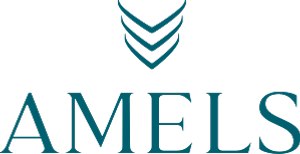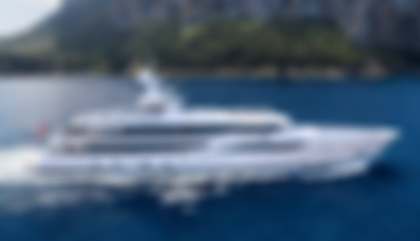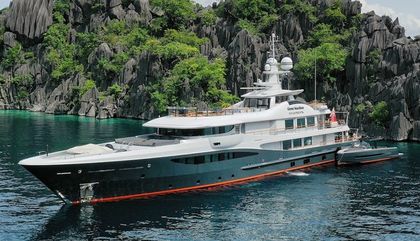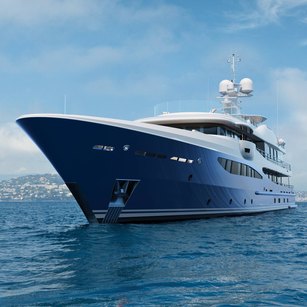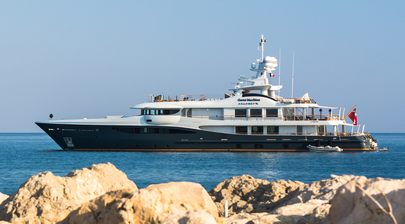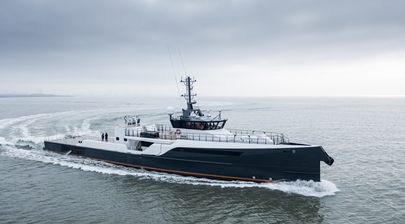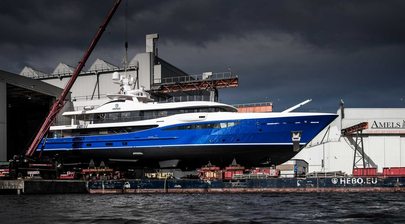-
MkYEARS2012 - 2020BUILT15
Amels 180 Yachts For Sale
The Amels 180 was built in the Netherlands by Amels with a multi-award winning international design team, exterior styling by Tim Heywood Design from the UK. The 55m/180'5" superyacht constructed in steel can sleep up to twelve guests across six cabins. She was available with only one option for inboard engines.
The 55m (180ft) Amels 180 is a steel full-displacement yacht from the Dutch builder’s Limited Editions range. It ran in production from 2012 to 2020 and extended their semi-custom approach in the high-end steel bracket with real range, proven systems, and steady charter draw.
Amels 180 Buyer's Guide
This guide is for anyone weighing the Amels 180 seriously - to see how these hulls were built, how they’ve aged, and what shapes their value today. Whether you’re eyeing a private programme or occasional charter, this guide helps turn a listing into a decision.
- Why Buy an Amels 180?
- Who Buys an Amels 180?
- Evolution of the Amels 180
- Design & Layout
- Performance & Engines
- Amels 180 Ownership & Running Costs
- Crewing & Operating an Amels 180
- Insuring & Registering your Amels 180
- Amels 180 Yachts for Sale: Market Price Insight
- Rivals & the Successor to the Amels 180
- Working with a Buyer's Broker
- Buy Smarter with YachtBuyer
Why Buy an Amels 180?
The Amels 180 still draws smart buyers because it solves real-world needs, not just on paper, but in miles logged and charters booked. It’s a yacht that holds up, both at sea and on the dock. Owners keep them, crews rate them, and brokers know they don’t linger long when priced right.
Built for Hard Use and Long Life
- Steel hull and shipyard-grade systems built by Dutch teams with Damen backing
- Surveyors report strong structural health even after 10-12 years of service
- Spare parts, drawings, and yard support still active from Amels service desk
- Known to cross oceans routinely - 4,500+ nm range not just on spec sheets
Better Than the Sum of Its Parts
- Hull, layout, and systems refined over 16 hulls
- Wide sun deck, fold-down balconies, and indoor-outdoor flow still match newer yachts
- Quiet ride and smooth handling praised by crew and guests on long passages
- Design holds guest comfort high without bloating size or adding systems bloat
Support Without Surprises
- Maintenance is predictable - standard 5- and 10-year refit cycles, no hidden gremlins
- Amels technical support still offers insight and parts for this model
- Engineers find the engine room clean and reachable
- Known service points (stabilizers, balconies, paint, teak) are well-documented by now
Why Buy a Used Amels 180?
Pre-owned Amels 180s are one of the few ways to step into a Northern European 670GT oceangoing yacht with true pedigree, without starting from scratch. Many resale examples come with seasoned crews, full service records, and proven charter earnings. Unlike one-off custom builds, this model benefits from a known platform: refits run smoother, systems are well mapped, and Amels still supports the class with parts and advice. Depreciation trends are steady with many holding around 70–75% of their original value after ten years.
Who Buys an Amels 180?
Amels 180 owners tend to be hands-on with how their yacht is run, even if they don’t helm it themselves. They are likely to be seasoned clients who’ve likely chartered before, maybe owned smaller steel yachts, and know what matters when you’re a week offshore with guests. These owners prize good crew spaces, quiet machinery, strong yard support and a proven hull that won’t keep them tied to the dock.
Some buy for the long haul, running tight shipyards and crews year-round. Others treat it as a smart bridge between short-term use and longer-term ownership, especially when paired with good charter returns. What links them all is trust in the Amels name, and the knowledge that a boat like this holds its shape and worth over time.
Buyers tend to fall into three groups:
- Family-cruising owners: They use the yacht for long summer runs in the Med or Caribbean, often with repeat crew and a child-friendly layout. Comfort, quiet, and shade matter more than speed or spectacle.
- Charter-savvy investors: These buyers know the yacht’s earnings history and see the 180 as a safe bet for a mixed-use program by chartering out on prime weeks, then enjoy it privately.
- Step-up owners: Moving from a 40m or custom composite yacht, they choose the Amels 180 for its yard pedigree, real-world range, and clean resale path. Often they’ve spent some time onboard before buying.
Captains often report that owners like the peace of mind this model brings, and the 180 has taught many that a semi-custom yacht can still feel built for one.
Where the Amels 180 Spends Its Time
- West Mediterranean: Most common summer base - charter-friendly, crewed, and well-suited for the 180’s draft and layout.
- Caribbean and Bahamas: Winters often spent here thanks to 4,500 nm range and solid charter draw; draft fits key anchorages.
- Indian Ocean and Maldives: A few owners use the yacht’s range and comfort to cruise farther afield, helped by stable layout and tech support.
Evolution of the Amels 180
The Amels 180 was in steady production from 2012 through 2020, with 16 hulls delivered over those eight years. The model saw subtle but steady tweaks across its run, especially in glazing, guest area flow, and some machinery fit-outs. For buyers today, these updates will matter: newer hulls tend to carry the latest AVIT, different layouts and other fixes learned from the earlier boats.
Original Launch (2012–2015)
The early hulls held close to the Amels 171 they evolved from, with stretched aft decks, fold-down balconies, and classic Tim Heywood lines. Inside, many used pale woods and lighter tones, with design direction often led by the owner’s team. Engineering leaned conservative: twin MTU 16V 2000 M70s were the standard fit. These builds set the platform’s reputation for long-legged range, quiet ride, and smooth resale. Buyers looking at these hulls will find strong build bones, though they may want to factor in AVIT and soft goods upgrades if not yet done.
Mid-Cycle Tweaks (2016–2018)
From hull 5 onward, the glazing line was adjusted: slightly larger windows in guest areas, often with sleeker mullions. The sundeck layouts were also refined on some units, with better shade and built-in bars. AV systems began to shift from standalone boxes to integrated networks. In machinery, zero-speed fin stabilisers became standard. Hulls like Lili and Elixir in this period also leaned toward darker interiors and higher-spec soft goods.
Late Builds and Final Series (2019–2020)
The last few hulls added updated nav equipment, cleaner exhaust setups, and better thermal insulation in crew and tech spaces. Some late builds were prepped for LY3 coding or had it fitted after delivery. The shipyard quietly integrated owner feedback on vibration and ambient noise as reports suggest these later hulls are marginally quieter under way. Buyers looking at these will often find the least to change, but they command a price premium and tend to sell privately or off-market.
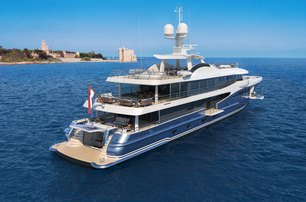


Design & Layout
For a 55-metre yacht, the Amels 180 makes its space work hard as owners and crew often say it "feels bigger than it is," and that’s down to good flow, storage and clean separation between guest and service areas.
On Deck
The sundeck is one of the Amels 180’s strongest points. It’s broad, with a central hot tub, sunpads fore and aft, and room for modular gym gear or lounge furniture. Owners like that the space can shift - yoga at dawn, bar at night. The upper deck aft holds a proper dining table, while the main deck aft suits welcome drinks or shaded lunch, with stairs down to a wide swim platform. Fold-out balconies on both sides of the main saloon add to the outdoor flow without feeling bolted-on.
Some later hulls in the series were configured for touch-and-go helicopter use, typically on the foredeck. These setups did not include hangars or full-time flight gear but offered a safe, reinforced zone for landings and are mainly for guest transfer or provisioning runs. Buyers interested in heli use should confirm reinforcement and classification details, as not all builds carried this spec.
Access routes are crew-friendly with vertical stairs connecting decks cleanly, and guest zones don’t bleed into service paths. The bow is clean and usable, often used for tenders or toys, though not always configured for seating. Deck furniture is often owner-chosen and varies by hull, but most include loose sun loungers and hideaway awnings.
Interior and Guest Accommodation
Inside, the Amels 180 typically carries a five-cabin layout, with a main-deck owner’s suite and four guest cabins below. Some hulls swapped a lower twin for a gym or massage space, but the five-cabin format remains standard. Main saloons are open-plan, with floor-to-ceiling windows and a clear line of sight aft. Skylounges on the bridge deck vary more and some include bar setups or media rooms, while others keep it light and lounge-led.
The crew circulation is strong: service stairs stay separate, laundry is tucked away, and the galley links well to both decks. Most builds used a closed galley, though a few owners pushed for semi-open or dual-access setups. Lighting improved across the series, with more indirect lighting and dimmable systems post-2016.
Tenders and Toys
The Amels 180 carries its main tenders in foredeck garages, launched by crane. Most builds included a main 7-8 metre (23-26 ft) custom limo tender and a smaller chase or rescue tender. Toys (jet-skis / SeaBobs) tend to live aft in the beach club area or on the swim platform. A few hulls built in crane or davit setups to help with heavier gear. The garage areas are tight but workable, with sliding doors and hydraulic hatches designed for solo-crew launch and recovery.
Performance & Engines
The Amels 180 runs on a full-displacement steel hull built for long crossings and steady motion. It’s made for comfort over pace, with power that’s tuned for range, not speed bursts. All builds use twin screw shafts and rudders, with no pods or jets. Ride quality and sea-keeping were priorities from the start, and it shows in how the hull trims clean, even with full fuel and tenders aboard.
Engine Options & Specifications
| Specification | Option 1 | Option 2 |
|---|---|---|
| Engine model | MTU 16V 2000 M70 | MTU 16V 2000 M72 |
| Power (per engine) | 1,408 kW (1,890 hp) | 1,440 kW (1,938 hp) |
| Total output | 2,816 kW (3,780 hp) | 2,880 kW (3,876 hp) |
| Top speed | 15.5 knots | 15.5 knots |
| Cruising speed | 13 knots | 13 knots |
| Economical range | 4,500 nm @ 12 knots | 4,500 nm @ 12 knots |
| Fuel capacity | 115,000 litres (30,378 US gal) | 115,000 litres (30,378 US gal) |
| Stabilisers | Quantum zero-speed fins (standard); early hulls used older controllers, newer builds added quieter, quicker-response units | |
Ride comfort on the Amels 180 is high thanks to the long waterline and fine-entry bow. Noise levels underway stay low, especially from the guest areas aft - with late-series hulls getting extra insulation and sound damping around machinery and bulkheads. The hull tracks well even at lower revs, and trim stays level unless fully loaded aft. At anchor, the Quantum stabilisers do their job quietly. The engine room is set aft and insulated, with wide walkways and good access for crew. Vibration reports are minor, though early hulls may show more transfer into the saloon if not retrofitted with updated dampers.
Survey Hot Spots
- Check lagging on main exhausts - older insulation may show wear or moisture ingress
- Inspect stabiliser seals and controller software as some hulls still run early firmware
- Look for pinholes or fairing cracks at hull joints and under balconies
- Review chiller plant hours and check backup pump rotation logs
- Engine mounts and shaft alignment
Amels 180 Ownership & Running Costs
The Amels 180 was built with long use in mind, not just in range but in how it wears. Owners who run the yacht full time tend to report steady, known upkeep cycles. That is helped by Amels’ ongoing support, so even a decade on, most yachts in this class are still in the water, and not mothballed.
Owners and managers would typically budget 8-12% of the yacht’s value each year in this size range, depending on crew size, flag, and use. For a yacht that originally cost just under €40 million, that means a working annual budget in the €3 to €5 million range is typical. Crew and dockage take the biggest bite. Fuel depends heavily on itinerary, but with a range of 4,500nm at cruise, long crossings are well within scope.
- Paint: Full resprays typically required every 5 to 7 years. High six-figure budgets depending on scope and yard.
- Stabilisers: Seal checks and firmware updates expected every 5 years. Later hulls may have newer control systems pre-installed.
- Chillers and HVAC: No public pricing. Buyers should request hour logs, coolant testing, and service records.
- Interior: Soft goods, lighting, and furniture typically refreshed on a 5 to 7 year loop. Some hulls now carry Starlink and AV upgrades.
- Yard Familiarity: MB92, Palumbo, Lürssen Hamburg, and Amels Vlissingen are common service points with deep knowledge of the class.
Charter-focused owners often fold refresh work into winter yard periods to avoid downtime in peak seasons. Refit planners familiar with the 180 platform can shorten timelines and reduce cost drift. The repeatable build makes punch lists more predictable than many bespoke yachts.
Crewing & Operating an Amels 180
The Amels 180 is a crew-run yacht that sits firmly in the light-commercial bracket. It is not owner-operated. It needs a skilled team to run smoothly, especially when used for both private cruising and charter. The setup is built for regular use, long crossings, and guest service without fuss.
The typical crew count is 12 to 13, depending on flag and how charter-active the program is. The layout supports that well. Crew routes are separate from guest paths, with direct access from galley to service areas. The mess is quiet and tucked away from engineering noise. Laundry and stores are grouped below, near the crew cabins and service stairs. There is room to work without walking through guest zones.
- Captain: Runs the bridge, handles port entry and clearance, tracks logs and updates the owner or manager
- Engineer: Oversees engines, gensets, HVAC, stabilisers and fuel system. Has clean access to all main equipment zones
- Chef: Manages stores, meal prep, galley kit and food waste. Galley links well with crew and guest dining zones
- Stews and Deckhands: Cross-trained to run table service, housekeeping, deck lines, water toys and tender launch
The yacht handles clean and steady. Thruster control and steering response are well-rated, even when short-crewed during med-moor. Helm sightlines are good from both stations, with no major blind spots except around tenders if stowed forward. The yacht tracks true at cruise and holds trim without heavy crew input. Stabilisers keep her flat at rest and under way. Captains note the hull feels light on the helm for her tonnage.
The bridge setup uses twin helm chairs, clear sightlines to port and starboard, and split-screen navigation. Most hulls now carry touchscreen power and tank monitoring, plus backup readouts. Later builds integrated chart, radar and comms more cleanly. Electricals are split across AC and DC with shore power input, genset cross-tie, and backup switchboards. Crew say the systems are readable and work clean even under load.
Legal and Operational Notes
At 55m / 180ft, the Amels 180 is large enough for real sea time but still under thresholds that trigger heavier regulation. The rules below are worth knowing but rarely cause delays in normal use.
- Pilotage: Required in many commercial ports for yachts over 30m, including some Med marinas and US entries
- Anchoring: Restricted in protected areas, especially in Posidonia zones off Spain, France and parts of the Adriatic
- Emissions: Yachts must comply with Tier II engine rules. Tier III not required for this class unless major refits trigger it
- Mooring: The 180 fits in most Med stern-to slips and alongside berths in US ports. Beam allows for marina access without tugs
- Charter Coding: LY3 or equivalent coding is common for this model. Many are commercially registered and meet MCA or Cayman rules
Day to day, the clear bridge setup, good sightlines, and clean crew flow help with safe running and long-term crew retention. That matters most on a yacht where sea time is the norm, not the exception.
Insuring & Registering your Amels 180
How you insure and flag an Amels 180 shapes how you use it day to day. Most are commercially flagged and run with full crews, often switching between private trips and charter bookings. Flag choice affects crew rules, port paperwork, and what upgrades are needed to charter. Insurance links closely to flag and use, so sorting both early helps owners avoid delays later.
Every buyer needs a few core types of cover. Most policies are written through marine specialists who know the class and can tailor terms to the yacht’s use plan.
- Hull & Machinery: covers the yacht itself, including damage to gear, systems, and engines.
- Protection & Indemnity (P&I): covers injury or damage involving other people, crew, or the sea itself (pollution).
- Add-ons: many owners add cover for tenders, toys, storm risk, personal effects, and loss-of-use claims.
Premiums are not fixed but tend to sit around 0.8 to 1.2 percent of the yacht’s insured value per year. Strong records, recent surveys, and a good crew file can lower the rate. Amels 180s that hold class with Lloyd’s or ABS and show steady service logs tend to be easier to place. Age matters too, but this model’s build quality and builder support often reassure underwriters even after ten years afloat.
Most Amels 180s fly offshore flags such as Cayman, Marshall Islands, or Malta. These make charter coding easier and help with crew rules, rotation, and resale. A few are flagged USCG, but that limits charter use and adds some domestic crewing rules. Offshore flags also keep the door open for private use with later commercial switchovers if the owner’s plans change.
VAT status shapes where the yacht can cruise or be shown for sale. Some Amels 180s are EU VAT paid, which makes Med charter simpler. Others use Temporary Import when brought into EU waters under offshore ownership. Buyers should check this early. Most are held in a Special Purpose Vehicle, often Cayman or Delaware based. This keeps ownership clean, makes resale faster, and separates tax planning from day-to-day use.
Amels 180 Charter Potential
Many Amels 180s were built to charter or were later brought into compliance. The MCA LY3 code is the most common. Yachts that were not delivered coded may need fire door upgrades, crew escape routes checked, new manuals, and liferaft cradles fitted. Most charter out of the West Med in summer and the Caribbean or Bahamas in winter. Charter managers often rate the Amels 180 as a known quantity that books steadily when kept fresh and well-crewed.
Well-kept records and a clear flag path make both insurance and resale simpler. A yacht that shows care on paper wins trust before the first viewing.
Amels 180 Yachts for Sale: Market Price Insight
The Amels 180 has stayed active on the resale market since the model’s debut in 2012. You can view current listings in the Used Amels 180 Yachts for Sale section, where photos and specs are kept up to date.
How the Amels 180 Trades
The 180 trades as a continuous line with no formal model splits, though later builds do carry small spec bumps. What matters most is the yacht’s care and upkeep. Fresh paint, updated stabiliser controls, and modern AV systems carry more weight than the build year alone. Clean logs and crew continuity are major selling points across the fleet.
Based on YachtBuyer Market Watch data, Amels 180s spend an average of 584 days on the market. That reflects a moderate but steady turnover pace for steel yachts in the 55m bracket. Listings priced close to recent deals tend to draw firmer offers. Price drops are shallow overall, averaging about 4.5 percent from original ask to final deal. Yachts with sound service files and charter-ready gear tend to trade faster than cosmetic-only refits.
The data is drawn from confirmed sales tracked in the YachtBuyer platform. Use it together with the live market data and current price gauges to get a grounded picture of how the Amels 180 moves today.
Historic Market Overview
Here you can explore the resale track over the past three years using current pricing records and trend graphs:
- Historic Prices – All Yachts: the chart shows a gentle decline through mid-2024, followed by a mild lift into late 2025, with most deals staying within a €28.8M to €40M band.
Rivals & the Successor to the Amels 180
The Amels 180 sits in the upper-mid range of the 55m steel segment, known for build strength, layout flow, and real-world range. It’s often weighed against lighter yachts with more showy lines or higher-spec builds with bigger teams behind them. Buyers looking at the 180 tend to value a proven platform, low upkeep surprises, and support from a long-running yard. For charts and deeper analysis, see the Amels 180 Rivals and Head-to-Heads.
Lower-Priced Rival: Benetti Classic Supreme 132
The Benetti Classic Supreme 132 runs shorter at 40.2m but carries similar guest volume due to a wide beam and lifted decks. Built in composite rather than steel, it trades punch for pace and keeps weight lower. Its upkeep costs are lighter, and dockage is simpler, but long-haul range and heavy-sea trim are not its strong points. Interiors lean brighter and more built-in. The hull moves faster but needs more care in chop. It suits warm-weather programs with short hops and dock-to-dock schedules.
Mid-Range Rival: Heesen 55M Steel
The Heesen 55M Steel is a closer match in size and hull form, though its Dutch styling leans more aggressive. It uses a full-displacement steel hull like the Amels 180 but aims for a slightly higher top speed and uses lighter joinery. Layouts vary more by hull, and the yard has shifted specs over time. Noise levels and finish are strong, though machinery access can be tighter in some builds. Owners like the sharper exterior and fuller-beam lounges, but crew often note less pantry and stores volume. Good for buyers who lean toward owner-forward design with modern trim.
Higher-End Rival: A 55M Feadship 55M
A 55m Used Feadship sits higher in both price and fitout. It brings stronger in-house design, tighter tolerances, and deeper crew spaces. Many are fully custom, so layout and refit logic vary sharply. The hull feel is excellent, and the engine room access is near top of class. However, upkeep demands are higher, and support needs more time from crew and managers. Owners who want full control of finish and can fund long refits often cross-shop here, but it is a different ownership rhythm than the semi-custom Amels platform.
The Successor: Amels 60
The Amels 60 replaced the 180 in 2020 as the next evolution in the Limited Editions line. It stretches to 60.0m (197ft) and gains volume significantly (about 830GT vs 671GT) with both a longer hull and a wider beam of 10.4m. The styling shifted to Espen Øino, replacing Tim Heywood’s softer profile with a sharper line and much larger glazing. There’s a new long pool aft, a full beach club with spa, and an owner’s deck with forward suite and private terrace. The layout now holds six guest cabins as standard, up from five on the 180.
Many of the changes reflect charter learnings from the 180: wider deck areas, better zoning, more leisure kit, and a layout built around guest use. Buyers choosing between a used 180 and a new 60 are mostly weighing tech and layout gains against cost and delivery time. The 60 starts around $75 to $80 million new which is roughly double what a 180 cost new.
Working with a Buyer's Broker
A good buyer’s broker checks facts, spots gaps, and helps match the yacht to how you plan to use it. That means more than reading specs. It means knowing what stabilisers are fitted, what work was done last winter, when the gensets were overhauled, and how the logbooks line up with what’s been claimed. On a yacht like the Amels 180, where hulls share a name but differ in hours, refits, and crew setup, the broker’s job is to read between the lines.
Early on, a broker will check the sale history, coding status, and key paperwork like stabiliser records, fuel polishing logs, and the most recent thermal scan. Tools like YachtBuyerPRO make it easier to compare hulls, track past listings, and see how long each yacht’s been in and out of yard. These checks help avoid surprises later. Asking price also gets checked against engine hours, interior condition, and ownership profile.
Once a yacht is shortlisted, the broker coordinates the survey, haul-out, and sea trial. That includes oil analysis, insurance pre-checks, and contract terms tied to survey results. If problems show up the broker helps adjust the offer or walk away cleanly.
After closing, a broker can help place crew, secure a yard slot, or advise on flag and mooring, and that kind of early legwork pays off.
Buy Smarter with YachtBuyer
Each Amels 180 has its own story: how it’s been kept and upgraded over time. Some have logged long-range crossings with charter guests aboard, others stayed closer to home in private hands. Knowing the yacht’s service trail, refit rhythm, and usage pattern helps buyers make clear, confident decisions without guesswork.
YachtBuyer tracks that story with verified sales data, live listing updates, and structured research across the series. You can compare hulls, trace system changes, and weigh one yacht’s running hours and upgrades against another’s refit history. The tools help buyers cut through surface polish and focus on what matters below deck.
If you're still narrowing your list, Reviews, Video Yacht Tours & Walkthroughs offer a real look at layout flow, deck use, and onboard feel. Seeing the yachts in motion or in dock helps make sense of the guide - and turns research into ready steps toward the right choice.
Market Price Insight
Current prices show that a 12-year-old Amels 180 is available from $35,351,000.
New Amels 180 - Built to order

Configure Your Own
Amels 60 Yacht
- Choose color, fabric & specification
- Select your layout
- Warranty & Dealer Support
- Fewer maintenance costs

Used Amels 180 Yachts for sale
View a wide selection of pre-owned Amels 180 Yacht for sale in your area, explore detailed information & find the perfect Amels 180 Yacht for you.
2 Pre-Owned Amels 180 Yachts for sale
Amels
M/Y G*****55m | Amels 180
2020
2 x MTU 1,308hp
Features: Stabilisers, Beach Club, Swim Platform, Aircon
Amels
2013 GENE MACHINE55m | Amels 180
2 x MTU 1,410hp
Miami, Florida, United States
1 Not for sale to US residents while in US waters
2 Approx Price Conversion
Pictures shown are for illustration purposes only. Actual Yacht may vary due to client options.
LIVE: Used Amels 180 Yacht Prices
Find out how much a pre-owned Amels 180 may cost based upon the asking price of all yachts currently for sale globally according to YachtBuyer Market Watch & our sales listings.
Market Price Insight
YachtBuyer’s Market Watch reports that there is currently only one pre-owned Amels 180 yacht for sale globally, built in 2013. It has a current asking price of £29 million. Being 12 years old, this vessel continues to hold its value thanks to its combination of luxury, performance, and timeless design. However, the launch of the Amels 60 in 2022 impacted the pricing of the Amels 180, as the newer model introduced updated features, cutting-edge technology, and a more contemporary design that shifted buyer demand. This has contributed to a more competitive pricing range for the Amels 180 models, highlighting how new Yacht launches influence the market for earlier generations.
Amels 180 Price
2012 - 2020
- Average Price £31.9m
- Price Range £29m - £34.7m
- Average Age 9 years
Recent Sales
-
Model YearLast Asking PriceSold Date
-
2020£35.1mMay-2025
-
2017£30.3mMay-2025
-
2017£29.6mOct-2024
Members Only Register - it's free
Average asking price according to YachtBuyer data (2 yachts available). Prices may vary depending on specification, condition and extras.
Historic Price Comparison
With nine of the 15 Amels 180 yachts built listed for sale over the past three years, as tracked by YachtBuyer’s Market Watch data, it demonstrates steady activity in its segment. These yachts spend an average of 586 days on the market, reflecting a moderate turnover rate for superyachts in this size segment. Over the same period, the marketed price tends to see a moderate average price reduction of 4.5% from the initial asking price, which demonstrates its ability to hold its value and shows continued interest from the market. Interestingly, this level of change is below the average price fluctuation for this size of superyacht, indicating a stable position in the market. These yachts have been offered for sale primarily around the west and central Mediterranean, and sometimes the US East Coast.
Amels 180 Yacht Price Trends & Sales Graphs (3-Year Data)
Amels 180 Model Overview & Timeline
Amels started development on the Amels 180 in 2012 and the first model rolled off the production line later the same year.
- Status
- Year
- Length
- Discontinued
- 2012 - 2020
- 55m (LOA)
- Beam
- Draft
- Speed
- 9.4m
- 3.38m full load
- 15.5 Knots
Amels 180 Awards
Rivals & Head-to-Head
Amels 180 Rivals
We've hand-picked a series of similar and direct rival yachts help you identify the strengths of the Amels 180 among its peers. These rivals include the Italian Sanlorenzo 57Steel and the Spanish Astondoa 185 Steel.
Head to Head
Visually compare everything from performance to layout for these closely matched models from competing builders.
Amels 180 News
Browse our collection of articles and commentary on the Amels 180 from Amels.
Amels 180 FAQ
A selection of frequently asked questions from buyers
-
The Amels 180 measures 180'5".
-
The Amels 180 has a top speed of 15.5 knots.
-
The Amels 180 was launched in 2012 and was in production for eight years.
-
Current prices show that a 12-year-old Amels 180 is available from $35,351,000.
-
Depending on your layout choice, the Amels 180 can support up to twelve guests in six cabins.
-
The Amels 180 is a Superyacht
-
To start the process of buying your own Amels Amels 180, please get in touch with us or contact a buyer’s broker.
We're committed to making yacht buying easier, so if you can't find what you're looking for just ask.

